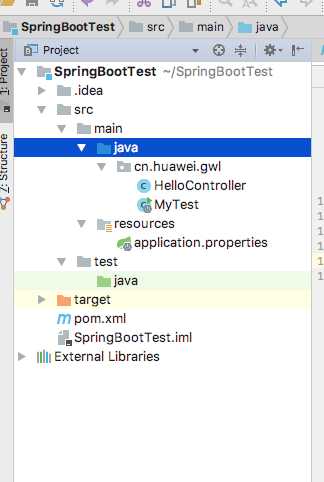标签:注入 org ott root main 操作 web option component
1.先使用idea创建maven项目(这个就不详细讲了,很简单的操作)
2.创建完maven项目之后添加springboot依赖,pom.xml文件如下:
<?xml version="1.0" encoding="UTF-8"?> <project xmlns="http://maven.apache.org/POM/4.0.0" xmlns:xsi="http://www.w3.org/2001/XMLSchema-instance" xsi:schemaLocation="http://maven.apache.org/POM/4.0.0 http://maven.apache.org/xsd/maven-4.0.0.xsd"> <modelVersion>4.0.0</modelVersion> <groupId>cn.tongdun.gwl</groupId> <artifactId>SpringBootTest</artifactId> <version>1.0-SNAPSHOT</version> <parent> <groupId>org.springframework.boot</groupId> <artifactId>spring-boot-starter-parent</artifactId> <version>1.5.1.RELEASE</version> </parent> <dependencies> <dependency> <groupId>junit</groupId> <artifactId>junit</artifactId> <version>3.8.1</version> <scope>test</scope> </dependency> <!--springboot依赖--> <dependency> <groupId>org.springframework.boot</groupId> <artifactId>spring-boot-starter-web</artifactId> </dependency> <dependency> <groupId>org.springframework.boot</groupId> <artifactId>spring-boot-devtools</artifactId> <optional>true</optional> </dependency> <dependency> <groupId>org.springframework.boot</groupId> <artifactId>spring-boot-starter-thymeleaf</artifactId> </dependency> </dependencies> <build> <finalName>hibernateSpringDemo</finalName> <plugins> <plugin> <groupId>org.springframework.boot</groupId> <artifactId>spring-boot-maven-plugin</artifactId> <configuration> <fork>true</fork> </configuration> </plugin> </plugins> </build> </project>
pom文件编写完毕,配置maven路径,并导入依赖.
3.接下来写一个SpringBoot入门程序
(1)新建类MyTest.java

1 package cn.huawei.gwl; 2 3 import org.springframework.boot.SpringApplication; 4 import org.springframework.boot.autoconfigure.SpringBootApplication; 5 import org.springframework.context.annotation.ComponentScan; 6 7 @SpringBootApplication 8 @ComponentScan(basePackages = "cn") 9 public class MyTest { 10 11 public static void main(String[] args) { 12 SpringApplication.run(MyTest.class, args); 13 } 14 }
需要注意的是:这个类的上面需要添加SpringBoot的注解@SpringBootApplication,然后在主函数中开始启动.
(2)然后创建一个HelloContreller类,用来测试SpringBoot
1 package cn.huawei.gwl; 2 3 import org.springframework.web.bind.annotation.PathVariable; 4 import org.springframework.web.bind.annotation.RequestMapping; 5 import org.springframework.web.bind.annotation.RestController; 6 7 8 @RestController 9 public class HelloController { 10 11 @RequestMapping("/say") 12 String home() { 13 System.out.println("get into"); 14 return "hello world"; 15 } 16 17 @RequestMapping("/hello/{name}") 18 String hello(@PathVariable String name) { 19 return "hello" + name; 20 } 21 }
需要注意的是这上面的几个注解:
4.在浏览器中输入:http://localhost:8080/say 和 http://localhost:8080/hello/haha 浏览器上即可得到输出结果.
SpringBoot程序验证完毕.
5.接下来再pom.xml文件里面添加要使用的jpa依赖:
1 <dependency> 2 <groupId>org.springframework.boot</groupId> 3 <artifactId>spring-boot-starter-data-jpa</artifactId> 4 </dependency> 5 <dependency> 6 <groupId>mysql</groupId> 7 <artifactId>mysql-connector-java</artifactId> 8 </dependency>
并导入依赖
6.添加依赖之后需要配置一些连接MySQL所需要的配置,创建一个application.properties:
1 spring.datasource.url = jdbc:mysql://localhost:3306/test 2 spring.datasource.username = root 3 spring.datasource.password = abcd1234 4 spring.datasource.driverClassName = com.mysql.jdbc.Driver 5 # Specify the DBMS 6 spring.jpa.database = MYSQL 7 # Show or not log for each sql query 8 spring.jpa.show-sql = true 9 # Hibernate ddl auto (create, create-drop, update) 10 spring.jpa.hibernate.ddl-auto = update 11 # Naming strategy 12 spring.jpa.hibernate.naming-strategy = org.hibernate.cfg.ImprovedNamingStrategy 13 # stripped before adding them to the entity manager 14 spring.jpa.properties.hibernate.dialect = org.hibernate.dialect.MySQL5Dialect
7.为main方法添加注解@EnableJpaRepositories
1 package cn.tongdun.gwl; 2 3 import org.springframework.boot.SpringApplication; 4 import org.springframework.boot.autoconfigure.SpringBootApplication; 5 import org.springframework.context.annotation.ComponentScan; 6 import org.springframework.data.jpa.repository.config.EnableJpaRepositories; 7 8 9 @SpringBootApplication 10 @EnableJpaRepositories 11 @ComponentScan(basePackages = "cn") 12 public class MyTest { 13 14 public static void main(String[] args) { 15 SpringApplication.run(MyTest.class, args); 16 } 17 }
8.接下来创建dao层,不过在这里是repository包,例如创建一个User实体,然后再创建一个UserRepository:
1 package cn.tongdun.gwl; 2 3 import org.springframework.data.jpa.repository.Query; 4 import org.springframework.data.repository.CrudRepository; 5 import org.springframework.data.repository.query.Param; 6 7 public interface UserRepository extends CrudRepository<User, Long> { 8 9 public User findOne(Long id); 10 11 public User save(User user); 12 }
这里面是创建一个UserRepository接口,并不需要创建UserRepository实现,springboot默认会帮你实现,继承自CrudRepository,@Param代表的是sql语句中的占位符,例如这里的@Param(“name”)代表的是:name占位符。
9.下面再控制层使用UserRepository,创建一个HibernateController:
1 package cn.tongdun.gwl; 2 3 import org.springframework.beans.factory.annotation.Autowired; 4 import org.springframework.boot.autoconfigure.EnableAutoConfiguration; 5 import org.springframework.stereotype.Controller; 6 import org.springframework.web.bind.annotation.RequestMapping; 7 import org.springframework.web.bind.annotation.ResponseBody; 8 9 import java.util.Date; 10 11 @Controller 12 @RequestMapping("/hibernate") 13 @EnableAutoConfiguration 14 public class HibernateController { 15 16 @Autowired 17 private UserRepository userRepository; 18 19 @RequestMapping("getUserById") 20 @ResponseBody 21 public User getUserById(Long id) { 22 User u = userRepository.findOne(id); 23 System.out.println("userRepository: " + userRepository); 24 System.out.println("id: " + id); 25 return u; 26 } 27 28 @RequestMapping("saveUser") 29 @ResponseBody 30 public void saveUser() { 31 User u = new User(); 32 u.setUserName("wan"); 33 u.setAddress("浙江省杭州市滨江区"); 34 u.setBirthDay(new Date()); 35 u.setSex("男"); 36 userRepository.save(u); 37 } 38 }
@Autowired代表按照类型注入,@Resource按照名称注入
至此,代码已经编写完毕,下面进入测试
10.访问http://localhost:8080/hibernate/saveUser 之后,jpa自动生成sql语句:

访问http://localhost:8080/hibernate/getUserById?id=2:

标签:注入 org ott root main 操作 web option component
原文地址:http://www.cnblogs.com/Mrwan/p/7366931.html